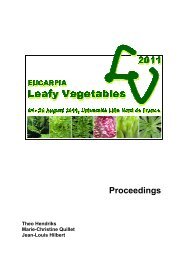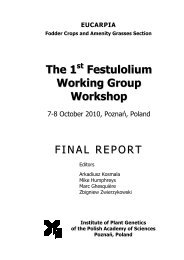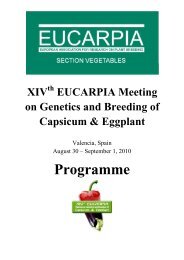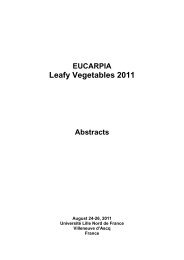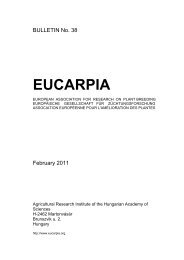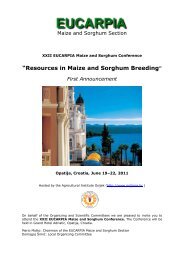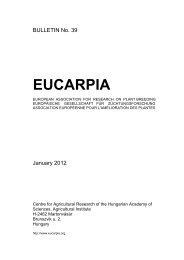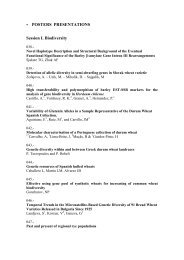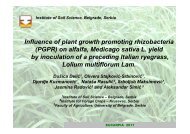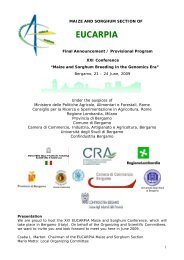Plant breeding for organic and sustainable, low-input agriculture
Plant breeding for organic and sustainable, low-input agriculture
Plant breeding for organic and sustainable, low-input agriculture
You also want an ePaper? Increase the reach of your titles
YUMPU automatically turns print PDFs into web optimized ePapers that Google loves.
On-farm dynamic management of wheat populations/varieties in <strong>organic</strong> <strong>agriculture</strong>: a<br />
way to valorize GxE interactions<br />
Isabelle Goldringer 1 , Galic Nathalie 1 , Rousselle Yves 1 , Demeulenaere Elise 2 , Bonneuil<br />
Christophe 3 , Payement Joël 4 , Berthellot Jean-François 4 , Chesneau Vincent 4 , Mercier Florent 4 ,<br />
Ferté Henri 4 , Pommart Alain 4 , Zaharia Hélène 4<br />
1 UMR de Génétique Végétale, INRA Univ. Paris Sud CNRS AgroParisTech, France; 2 ENS,<br />
CERES, Paris, France; 3 CNRS - EHESS – MNHN, Paris, France; 4 Réseau Semences<br />
Paysannes, Brens, France<br />
Numerous studies of traditional agricultural systems in the South have shown that the farmers<br />
practices <strong>for</strong> seeds management were the key <strong>for</strong> local adaptation whilst maintening the genetic<br />
diversity, due to the co-exixtence in the populations of all evolutionary mecanisms: selection,<br />
genetic drift, migration, mutation (Smith et al., 2001 ; Almekinder et al., 2000 ; Louette et al.,<br />
1997 ; Bertaud et al., 2001 ; Elias et al., 2001). Hence, this can be described as a dynamic<br />
management approach. In industrialized countries, such approaches are usually developped<br />
through the cooperation of farmers <strong>and</strong> breeders <strong>and</strong>/or researchers, <strong>and</strong> they might be of a great<br />
interest <strong>for</strong> <strong>organic</strong> or <strong>low</strong> <strong>input</strong> farming systems where the effects of environment <strong>and</strong> practices<br />
combine to produce a large range of contrasted conditions. Yet, these approaches are scarce <strong>and</strong><br />
they still do not have found a clear position in the seed regulation framework in France.<br />
To help on farm management or participatory approaches to find an official recognition, we are<br />
conducting a sociological, historical, ethno-botanical study of the actors, <strong>and</strong> a parallel genetic<br />
study of the varieties/populations in order to assess the ability of farmers networks to conserve<br />
<strong>and</strong> develop genetic diversity through local adaptation <strong>and</strong> seeds exchanges. Here, we present a<br />
case study of an old wheat variety (Rouge de Bordeaux, RB) grown <strong>for</strong> several generations in<br />
different farms under different conditions <strong>and</strong> farming practices. This old variety (~1880) has<br />
recently spread over <strong>organic</strong> farms in France due to its high “artisanale” bread making quality<br />
<strong>and</strong> good adaptation to <strong>organic</strong> conditions. Seeds samples were collected <strong>for</strong> about 25 different<br />
farmers RB varieties as well as <strong>for</strong> 4 RB accessions from the Inra collection. In 2006-2007, they<br />
were assessed phenotypically in 6 farms <strong>and</strong> in a research station (Le Moulon). Leaf samples of<br />
20-35 individuals / RB-sample were collected, DNA was extracted <strong>and</strong> they will be genotyped<br />
with a set of “neutral” SSR markers <strong>and</strong> markers of the VRN1 loci (vernalization response).<br />
Based on the sociological survey, a partial network of seeds exchange was drawn indicating<br />
complex <strong>and</strong> active exchanges, especially <strong>for</strong> the variety RB. The first phenotypic data show that<br />
the different samples are significantly differentiated with regards to their early development <strong>and</strong><br />
to their vernalization response. Within-sample phenotypic <strong>and</strong> genetic diversity will be studied<br />
together with the differentiation between samples at both levels.<br />
14




